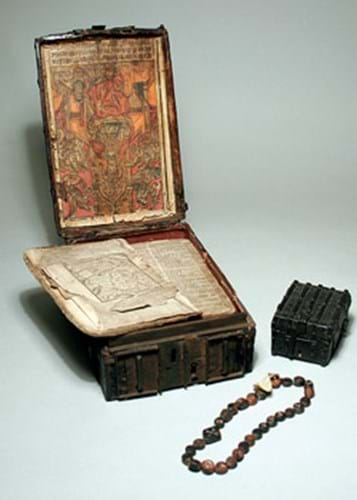
It was catalogued as "A 16th century bronze mounted bible box and rosary case both with contents, the bible leather mounted imprinted at London by Christopher Barker...1587" and given an estimate of £2000-3000.
Some may have wondered if the Bible had any value. As a late printing of the Geneva Bible it was probably only worth a couple of hundred pounds as a source for missing leaves in other, less derelict copies. But the London dealer who bought it recognised the box as a medieval rarity sometimes called a coffret messager.
The new owner had been alerted by his recollection of a sale held last November in Paris by Pierre Bergé. This was the dispersal of one of the more arcane and unusual parts of the collections formed by Marie-Thérèse and André Jammes, a sale that contained over 20 of these curious boxes.
Several theories exist as to the function of these strongboxes with religious woodcuts pasted inside the lid, but one is that they were medieval messenger boxes with secret compartments for concealing important documents and that the lid, when opened up, turned the box into a sort of miniature personal shrine or altar.
A 1931 census of these late medieval boxes produced by W.L. Schreiber located 36 different woodcuts (plus 13 duplicates) around the world and Arsène Bonafous-Murat estimated that about 60 in all may survive.
The Jammes collection itself contained no fewer than 22 boxes with different woodcuts, eight more than the Bibliothèque Nationale - though they did of course add to that number with the two pre-emptive purchases mentioned above.
The only British location cited by Schreiber was an example in the Ashmolean, but we now have the Rotherham coffret to add to that list. The stencil woodcut pasted into the lid has been identified as God the Father enthroned, after the Master of the Très Petites Heures of Anne de Bretagne.
There was a coffret in the Jammes sale bearing this same God the Father enthroned woodcut after the same Master. It was one of those left unsold, on an estimate of Euro40,00-50,000, but the Rotherham copy, though it shows some browning and a few wormholes, is in better condition than the three other recorded survivors and has particularly strong colouring.




